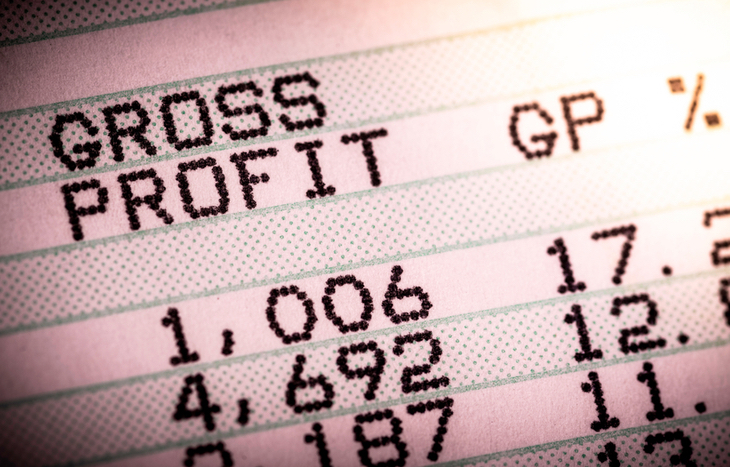What is Gross Profit?
Companies need to generate profit to stay afloat. They do this by producing goods or services and selling them for more than it costs to produce them. This difference is the company’s gross profit: revenue minus the cost of producing goods or the services sold. If the number is positive, it means the company is selling efficiently; if it’s negative, it means the company is losing money.
Gross profit is a powerful indicator of a company’s production efficiency. How well is the company using labor and supplies to produce saleable goods at a profit? This is something investors will look at as they evaluate the strength of a business and its prospects as an investment.
Here’s a look at why it’s important and what it means to calculate and understand it as a core financial evaluation metric.

How to Calculate Gross Profit
Gross profit also goes by sales profit or gross income, and the names are relatively interchangeable. Regardless, they’re all calculated the exact same way. The formula is a relatively simple one, specifically focused on taking the difference of COGS and revenue:
Gross Profit = Revenue − Cost of Goods Sold
Companies use this equation as a yardstick for comparing company performance. For example, it might compare the gross profit from the current quarter to the last quarter, or the previous year’s quarter. Calculating over time allows companies to see rises and falls in efficiency and identify the catalysts behind them. A company might also compare its gross profits to a competitor, to see how it stacks up.
Examples
XYZ Company has revenues of $1M over the course of the fiscal year. COGS represent $800,000. The company’s gross profit for the year is $200,000. That said, it’s important to remember that this figure doesn’t represent fixed costs, such as the rent the company pays on its building. Its net income is likely to be lower as a result.
Companies will also use it to calculate gross margin, represented as a percentage of revenue. In the example above, the company’s gross margin is 20%: profit of $200,000 on $1M in revenues. Companies frequently report gross margin and gross profit together, juxtaposed.
What Factors into Gross Profit?
The biggest contributing factors for a company’s gross profit are variable expenses. They rise and fall frequently, leading to variability in COGS. Companies that are able to reduce or control variable costs tend to see higher gross margins and, in turn, higher gross profits. A company may see higher or lower gross profit over a period due to changes in any of the following costs:
- Materials
- Labor costs
- Sales commissions
- Processing fees
- Equipment costs
- Utilities
- Shipping
Gross profit doesn’t include fixed costs. This includes rent, fixed salaries, insurance and the like, which are operating expenses. That said, these costs eventually factor into the fixed cost of each good sold through absorption accounting under Generally Accepted Accounting Principles (GAAP).
Pricing also factors into it. The higher the price of a unit, the more accommodation there is for variable costs. If it costs $10 to produce a Widget and the company sells it for $20, its gross profit is $10. If the company sold it for $50, it would still cost $10 to produce, however the gross profit would be $40.
Net Income Comparison
Gross profit is often confused with net profit; however, the two are different. It’s the amount of revenue leftover after subtracting COGS. Net income is a company’s profit after subtracting all expenses from revenue. It provides a more complete picture of the company’s free cash flow. Higher net income numbers represent a strong, healthy business-especially when they’re sustained over time. Gross profits are often a strong contributor to net income, but the two aren’t the same thing.
When looking at the two metrics together, it’s best to consider what proportion of net income is attributable to it. Strong gross profits often contribute to sustainable income, which fuels the company as it grows larger.
Operating Profit Comparison
Gross profit and operating profit are not the same. Operating profit—also known as earnings before interest and tax (EBIT)—is a company’s profitability before interest and taxes. Gross profit is merely the profit generated through the sale of goods or services, less COGS. Operating profit is much more comprehensive, since it takes into account all the company’s income and expenses.
While both are important financial indicators when it comes to evaluating a business, gross profit offers a much more focused look at core business sales. For example, strong investment performance and poor sales might give a company tremendous operating profits. This factors into how investors evaluate a company over the long-term, including its ability to sustain operations through strong sales.
Is the Business Profitable?
When it comes to financial reporting, there are a lot of different metrics that can signal how a business generates profit. Chief among them is its gross profit: the gains attributable to its ability to efficiently produce and sell products or services. Companies with strong gross profits demonstrate a healthy sales pipeline, and positive free cash flow tends to follow. This leads to reinvestment in the business, which begets new growth and scale that brings even more profitability with it. As an investor, it’s important to understand this data fully and make better decisions for your portfolio. Therefore, sign up for the Profit Trends e-letter below and discover stock tips and trends from some of Wall Street’s leading experts.





